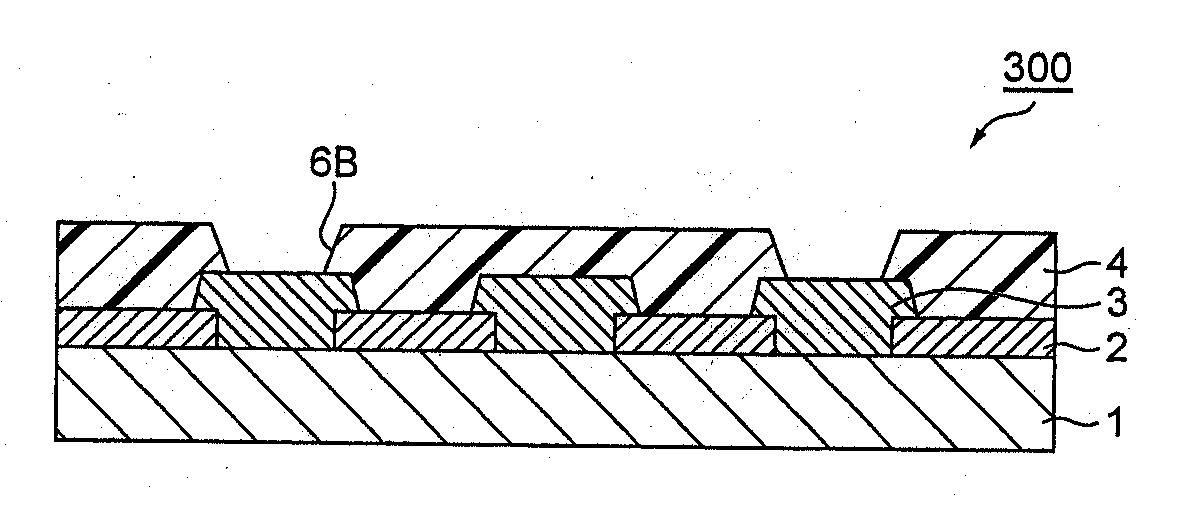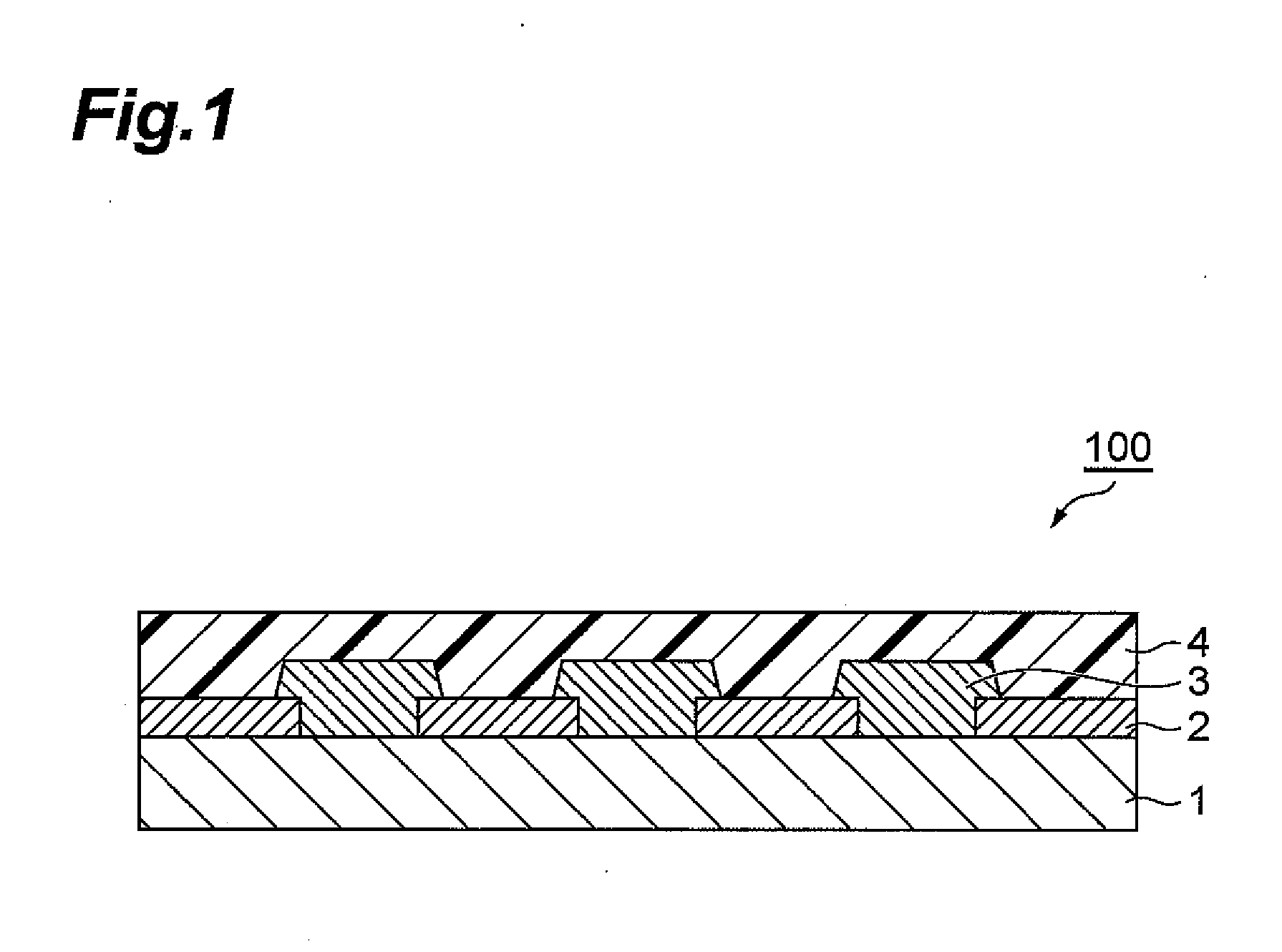Positive-type photosensitive resin composition, method for production of resist pattern, semiconductor device, and electronic device
a technology of photosensitive resin and composition, which is applied in the direction of photosensitive materials, semiconductor/solid-state device details, instruments, etc., can solve the problems of loss of thickness, imperfect imidation, and reduced dimensional accuracy, so as to prevent damage to electronic devices caused by heat, improve dimensional accuracy, and high sensitivity and resolution
- Summary
- Abstract
- Description
- Claims
- Application Information
AI Technical Summary
Benefits of technology
Problems solved by technology
Method used
Image
Examples
synthesis example 1
Synthesis of a Phenol Resin (A1) Modified by a Compound (Drying Oil) Having a Unsaturated hydrocarbon Group Having 4 to 100 Carbon Atoms
[0184]100 parts by mass of a phenol derivative obtained by mixing m-cresol and p-cresol in a mass ratio of 60:40 was mixed with 11 parts by mass of twig oil and 0.01 parts by mass of p-toluenesulfonic acid, and stirred at 120° C. for 2 hours to obtain a compound a of a drying oil modified phenol derivative. Next, 117 g of the above-mentioned compound a, 16.3 g of paraformaldehyde, and 1.1 g of oxalic acid were mixed, and reacted by stirring the mixture for 3 hours at 90° C. Next, a temperature of the reaction mixture was raised to 120° C., and the reaction mixture was stirred under reduced pressure for 3 hours. Subsequently, the reaction mixture was cooled to room temperature under atmospheric pressure to obtain a drying oil modified phenol resin (A1) as the reaction product. A weight average molecular weight of the A1 of 13,000 was determined by st...
synthesis example 2
Synthesis of a Phenol Resin (A2) Modified with a Compound (Drying Oil) Having an Unsaturated Hydrocarbon Group Having 4 to 100 Carbon Atoms
[0185]100 parts by mass of phenol, 11 parts by mass of linseed oil, and 0.1 parts by mass of trifluoromethanesulfonic acid were mixed, and stirred at 120° C. for 2 hours to obtain a compound b of a drying oil modified phenol derivative. Then, 101 g of the above-mentioned compound b, 16.3 g of paraformaldehyde, and 1.0 g of oxalic acid were mixed, and reacted by stirring the mixture for 3 hours at 90° C. Next, a temperature of the reaction mixture was raised to 120° C., and the reaction mixture was stirred under reduced pressure for 3 hours. Subsequently, the reaction mixture was cooled to room temperature under atmospheric pressure to obtain a drying oil modified phenol resin (A2) as the reaction product. A weight average molecular weight of the A2 of 10,000 was determined by standard polystyrene conversion of the GPC method.
synthesis example 3
Synthesis of a Phenol Resin (A3) Modified by a Compound (Drying Oil) Having an Unsaturated Hydrocarbon Group Having 4 to 100 Carbon Atoms
[0186]100 parts by mass of phenol, 43 parts by mass of linseed oil, and 0.1 parts by mass of trifluoromethanesulfonic acid were mixed, and stirred at 120° C. for 2 hours to obtain a compound c of a drying oil modified phenol derivative. Then, 130 g of the above-mentioned compound c, 16.3 g of paraformaldehyde, and 1.0 g of oxalic acid were mixed, and reacted by stirring the mixture for 3 hours at 90° C. Next, a temperature of the reaction mixture was raised to 120° C., and the reaction mixture was stirred under reduced pressure for 3 hours. Subsequently, the reaction mixture was cooled to room temperature under atmospheric pressure to obtain a drying oil modified phenol resin (A3) as the reaction product. A weight average molecular weight of the A3 of 25,000 was determined by standard polystyrene conversion of the GPC method.
PUM
| Property | Measurement | Unit |
|---|---|---|
| temperature | aaaaa | aaaaa |
| reaction temperature | aaaaa | aaaaa |
| mole ratio | aaaaa | aaaaa |
Abstract
Description
Claims
Application Information
 Login to View More
Login to View More - R&D
- Intellectual Property
- Life Sciences
- Materials
- Tech Scout
- Unparalleled Data Quality
- Higher Quality Content
- 60% Fewer Hallucinations
Browse by: Latest US Patents, China's latest patents, Technical Efficacy Thesaurus, Application Domain, Technology Topic, Popular Technical Reports.
© 2025 PatSnap. All rights reserved.Legal|Privacy policy|Modern Slavery Act Transparency Statement|Sitemap|About US| Contact US: help@patsnap.com



